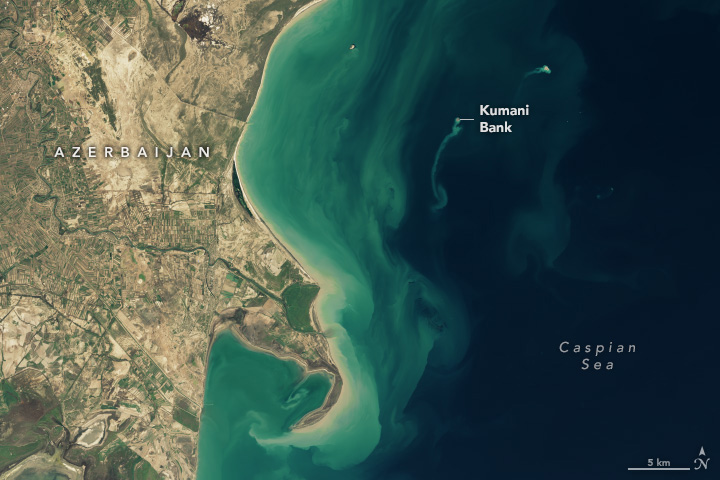Back in 2023, just 25 kilometers (15.5 miles) off the eastern coast of Azerbaijan, a new island was born. This wasn’t just any island though – it was formed by the eruption of a mud volcano and soon, it’ll have completely disappeared.
The mud volcano in question is known as Kumani Bank and, as shown in images captured by cameras on the Landsat 8 and 9 satellites, it had erupted enough material to form a so-called “ghost” island by the middle of February 2023.
This region is no stranger to mud volcanoes; over 300 have been reported in eastern Azerbaijan and its adjacent waters. Nor is it unfamiliar with their eruption, with Kumani Bank having been documented as erupting at least eight times previously, the first record being all the way back in 1861.

Kumani Bank, as shown in relation to Azerbaijan.
Image credit: NASA Earth Observatory images by Wanmei Liang, using Landsat data from the U.S. Geological Survey
However, such islands don’t tend to last for long. As University of Adelaide geologist Mark Tingay explained in a post to Threads, “We call these emergent (or ‘peek-a-boo’ or ‘ghost’) islands because they appear very suddenly, but are then rapidly washed away by the waves and slip back beneath the seas and disappear within a few months or years.”
In its February 2023 form, Tingay said that the island was about 400 meters (1,312 feet) wide. Fast-forward to December 25, 2024, and satellite images appear to show that only a fraction of that width remains, the crest of the volcano barely peeking above the surface of the water.
What is a mud volcano?
Technically, mud volcanoes are more volcanic in vibes than actually being considered to be “true” volcanoes. That’s because they spew out a fluid mixture of sediments and gas rather than lava – but tectonic activity might still be involved.
Scientists are still working to understand the process, but it’s thought that tectonic activity could pressurize subsurface sediment, forcing it upward until bursts through the surface, landing to form a cone of “mud”. If not tectonics, it could be down to the accumulation of natural gas.
Mud volcanoes aren’t to be looked over in comparison to their “real” counterparts either. While generally thought of as less hazardous than regular volcanoes, we know thanks to places like Kumani Bank that there are instances where mud volcano eruptions are violent enough to create entire new islands.
At other times, eruptions of mud volcanoes have featured huge fireballs. Most famously, this took the form of a 488-meter (1,600-foot) plume back when the Dashli Island mud volcano, also in the Caspian Sea, erupted back in 2021 – though fireballs have also occurred at Kumani Bank.
It’s not entirely clear why this fiery display happens, but it’s thought it could have something to do with the spontaneous combustion of the gases released, or the clashing of rocks causing a spark.
[H/T: NASA Earth Observatory]
Source Link: There’s A “Ghost” Island In The Caspian Sea, Birthed By A Mud Volcano